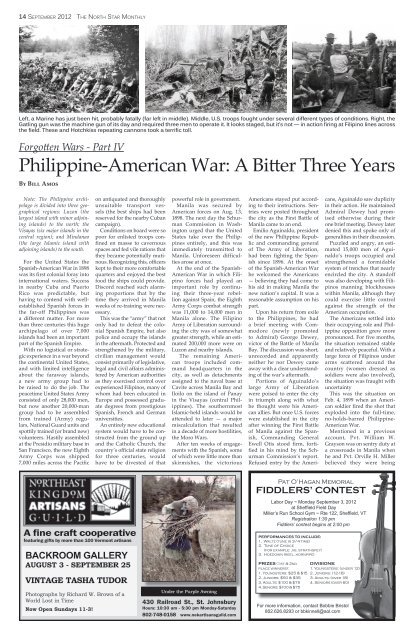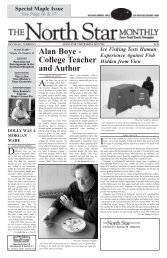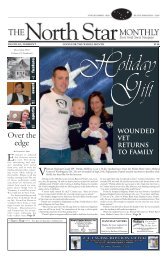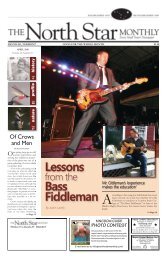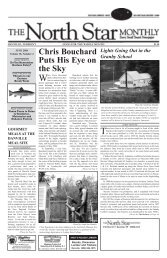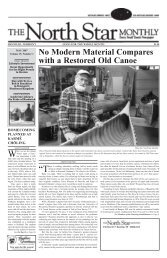September - The North Star Monthly
September - The North Star Monthly
September - The North Star Monthly
Create successful ePaper yourself
Turn your PDF publications into a flip-book with our unique Google optimized e-Paper software.
14 <strong>September</strong> 2012 <strong>The</strong> <strong>North</strong> <strong>Star</strong> <strong>Monthly</strong><br />
Left, a Marine has just been hit, probably fatally (far left in middle). Middle, U.S. troops fought under several different types of conditions. Right, the<br />
Gatling gun was the machine gun of its day and required three men to operate it. It looks staged, but it’s not — in action firing at Filipino lines across<br />
the field. <strong>The</strong>se and Hotchkiss repeating cannons took a terrific toll.<br />
Forgotten Wars - Part IV<br />
Philippine-American War: A Bitter Three Years<br />
By Bill Amos<br />
Note: <strong>The</strong> Philippine archipelago<br />
is divided into three geographical<br />
regions: Luzon (the<br />
largest island with minor adjoining<br />
islands) to the north; the<br />
Visayas (six major islands in the<br />
central region); and Mindanao<br />
(the large Islamic island with<br />
adjoining islands) to the south.<br />
For the United States the<br />
Spanish-American War in 1898<br />
was its first colonial foray into<br />
international waters. Success<br />
in nearby Cuba and Puerto<br />
Rico was predictable, but<br />
having to contend with wellestablished<br />
Spanish forces in<br />
the far-off Philippines was<br />
a different matter. For more<br />
than three centuries this huge<br />
archipelago of over 7,000<br />
islands had been an important<br />
part of the Spanish Empire.<br />
With no logistical or strategic<br />
experience in a war beyond<br />
the continental United States,<br />
and with limited intelligence<br />
about the faraway islands,<br />
a new army group had to<br />
be raised to do the job. <strong>The</strong><br />
peacetime United States Army<br />
consisted of only 28,000 men,<br />
but now another 20,000-man<br />
group had to be assembled<br />
from trained (Army) regulars,<br />
National Guard units and<br />
spottily trained (or brand new)<br />
volunteers. Hastily assembled<br />
at the Presidio military base in<br />
San Francisco, the new Eighth<br />
Army Corps was shipped<br />
7,000 miles across the Pacific<br />
on antiquated and thoroughly<br />
unsuitable transport vessels<br />
(the best ships had been<br />
reserved for the nearby Cuban<br />
campaign).<br />
Conditions on board were so<br />
poor for enlisted troops confined<br />
en masse to cavernous<br />
spaces and fed vile rations that<br />
they became potentially mutinous.<br />
Recognizing this, officers<br />
kept to their more comfortable<br />
quarters and enjoyed the best<br />
food the ships could provide.<br />
Discord reached such alarming<br />
proportions that by the<br />
time they arrived in Manila<br />
weeks of re-training were necessary.<br />
This was the “army” that not<br />
only had to defeat the colonial<br />
Spanish Empire, but also<br />
police and occupy the islands<br />
in the aftermath. Protected and<br />
strengthened by the military,<br />
civilian management would<br />
consist primarily of legislative,<br />
legal and civil affairs administered<br />
by American authorities<br />
as they exercised control over<br />
experienced Filipinos, many of<br />
whom had been educated in<br />
Europe and possessed graduate<br />
degrees from prestigious<br />
Spanish, French and German<br />
universities.<br />
An entirely new educational<br />
system would have to be constructed<br />
from the ground up<br />
and the Catholic Church, the<br />
country’s official state religion<br />
for three centuries, would<br />
have to be divested of that<br />
powerful role in government.<br />
Manila was secured by<br />
American forces on Aug. 13,<br />
1898. <strong>The</strong> next day the Schurman<br />
Commission in Washington<br />
urged that the United<br />
States take over the Philippines<br />
entirely, and this was<br />
immediately transmitted to<br />
Manila. Unforeseen difficulties<br />
arose at once.<br />
At the end of the Spanish-<br />
American War in which Filipino<br />
forces had played an<br />
important role by continuing<br />
their three-year rebellion<br />
against Spain, the Eighth<br />
Army Corps combat strength<br />
was 11,000 to 14,000 men in<br />
Manila alone. <strong>The</strong> Filipino<br />
Army of Liberation surrounding<br />
the city was of somewhat<br />
greater strength, while an estimated<br />
200,000 more were on<br />
Luzon and nearby islands.<br />
<strong>The</strong> remaining American<br />
troops included command<br />
headquarters in the<br />
city, as well as detachments<br />
assigned to the naval base at<br />
Cavite across Manila Bay and<br />
Iloilo on the island of Panay<br />
in the Visayas (central Philippines).<br />
<strong>The</strong> southernmost<br />
Islamic-held islands would be<br />
attended to later — a major<br />
miscalculation that resulted<br />
in a decade of more hostilities,<br />
the Moro Wars.<br />
After ten weeks of engagements<br />
with the Spanish, some<br />
of which were little more than<br />
skirmishes, the victorious<br />
Americans stayed put according<br />
to their instructions. Sentries<br />
were posted throughout<br />
the city as the First Battle of<br />
Manila came to an end.<br />
Emilio Aguinaldo, president<br />
of the new Philippine Republic<br />
and commanding general<br />
of <strong>The</strong> Army of Liberation,<br />
had been fighting the Spanish<br />
since 1896. At the onset<br />
of the Spanish-American War<br />
he welcomed the Americans<br />
— believing they had come to<br />
his aid in making Manila the<br />
new nation’s capital. It was a<br />
reasonable assumption on his<br />
part.<br />
Upon his return from exile<br />
to the Philippines, he had<br />
a brief meeting with Commodore<br />
(newly promoted<br />
to Admiral) George Dewey,<br />
victor of the Battle of Manila<br />
Bay. <strong>The</strong> discussion was short,<br />
unrecorded and apparently<br />
neither he nor Dewey came<br />
away with a clear understanding<br />
of the war’s aftermath.<br />
Portions of Aguinaldo’s<br />
large Army of Liberation<br />
were poised to enter the city<br />
in triumph along with what<br />
he thought were his American<br />
allies. But once U.S. forces<br />
were established in the city<br />
after winning the First Battle<br />
of Manila against the Spanish,<br />
Commanding General<br />
Ewell Otis stood firm, fortified<br />
in his mind by the Schurman<br />
Commission’s report.<br />
Refused entry by the Americans,<br />
Aguinaldo saw duplicity<br />
in their action. He maintained<br />
Admiral Dewey had promised<br />
otherwise during their<br />
one brief meeting. Dewey later<br />
denied this and spoke only of<br />
generalities in their discussion.<br />
Puzzled and angry, an estimated<br />
15,000 men of Aguinaldo’s<br />
troops occupied and<br />
strengthened a formidable<br />
system of trenches that nearly<br />
encircled the city. A standoff<br />
was also developing with Filipinos<br />
manning blockhouses<br />
within Manila, although they<br />
could exercise little control<br />
against the strength of the<br />
American occupation.<br />
<strong>The</strong> Americans settled into<br />
their occupying role and Philippine<br />
opposition grew more<br />
pronounced. For five months,<br />
the situation remained stable<br />
and relatively peaceful. With a<br />
large force of Filipinos under<br />
arms scattered around the<br />
country (women dressed as<br />
soldiers were also involved),<br />
the situation was fraught with<br />
uncertainty<br />
This was the situation on<br />
Feb. 4, 1899 when an American<br />
soldier fired the shot that<br />
exploded into the full-time,<br />
no-holds-barred Philippine-<br />
American War.<br />
Mentioned in a previous<br />
account, Pvt. William W.<br />
Grayson was on sentry duty at<br />
a crossroads in Manila when<br />
he and Pvt. Orville H. Miller<br />
believed they were being<br />
A fine craft cooperative<br />
featuring gifts by more than 100 Vermont artisans<br />
BACKROOM GALLERY<br />
AUGUST 3 - SEPTEMBER 25<br />
VINTAGE TASHA TUDOR<br />
Photographs by Richard W. Brown of a<br />
World Lost in Time<br />
Now Open Sundays 11-3!<br />
Under the Purple Awning<br />
430 Railroad St., St. Johnsbury<br />
Hours: 10:30 am - 5:30 pm Monday-Saturday<br />
802-748-0158 www.nekartisansguild.com<br />
Pat O’Hagan Memorial<br />
FIDDLerS’ CONteSt<br />
Labor Day ~ Monday <strong>September</strong> 3, 2012<br />
at Sheffi eld Field Day<br />
Miller’s Run School Gym ~ Rte 122, Sheffi eld, VT<br />
Registration 1:30 pm<br />
Fiddlers’ contest begins at 2:00 pm<br />
perFOrmANCeS tO INCLUDe:<br />
1. Waltz (tune in 3/4 time)<br />
2. Tune of Choice<br />
(for example: jig, strathspey)<br />
3. Hoedown (reel, hornpipe)<br />
prIZeS (1st & 2nd<br />
place winners):<br />
1. Youngsters: $25 & $15<br />
2. Juniors: $50 & $35<br />
3. Adults: $100 & $75<br />
4. Seniors: $100 & $75<br />
DIVISIONS:<br />
1. Youngsters: (under 12)<br />
2. Juniors: (12-18)<br />
3. Adults: (over 18)<br />
4. Seniors (over 60)<br />
For more information, contact Bobbie Bristol<br />
802.626.8293 or bbkinnell@aol.com


